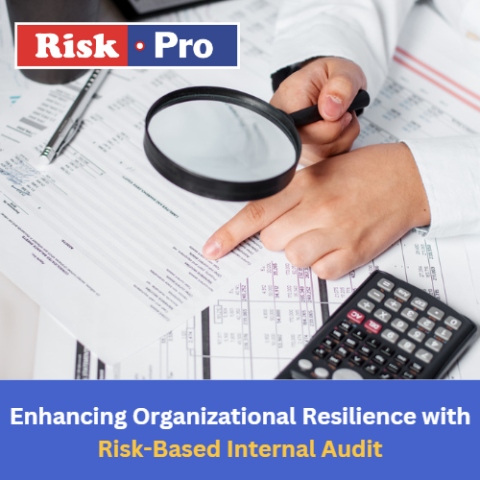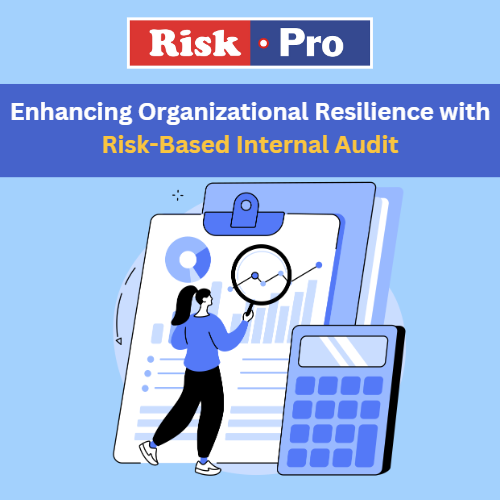
In today's dynamic business environment, organizations face a multitude of risks that can impact their operations, financial stability, and reputation. To effectively address these risks, internal audit functions have evolved to adopt a risk-based approach. Risk-based internal audit aligns audit activities with an organization's risk profile, enabling proactive identification and mitigation of potential risks. In this blog post, we will explore the concept of risk-based internal audit and its significance in enhancing organizational resilience.
Understanding Risk-Based Internal Audit:
Risk-based internal audit is an approach that focuses audit activities on areas with the highest risk exposure. It involves assessing an organization's risk profile, identifying key risks, and prioritizing audit resources accordingly. This approach ensures that internal audit functions are aligned with the organization's objectives and contribute to the overall risk management framework.
The Benefits of Risk-Based Internal Audit:
Adopting a risk-based approach to internal audit offers several advantages for organizations:
a. Enhanced Risk Management: Risk-based internal audit allows organizations to proactively identify and mitigate risks by focusing audit efforts on high-risk areas. This helps prevent potential issues before they escalate and impact the organization's performance.
b. Optimal Resource Allocation: By aligning audit resources with areas of higher risk, organizations can optimize the allocation of their limited internal audit resources. This ensures that audits are conducted where they are most needed, maximizing the impact of internal audit activities.
c. Business Alignment: Risk-based internal audit ensures that audit activities are aligned with the organization's strategic objectives and risk appetite. This strengthens the role of internal audit as a valuable partner in achieving organizational goals.
d. Improved Decision Making: Risk-based internal audit provides management and stakeholders with reliable and timely information about potential risks and control effectiveness. This supports informed decision making and enhances overall governance processes.
e. Regulatory Compliance: By focusing on high-risk areas, risk-based internal audit helps organizations meet regulatory and compliance requirements. This reduces the risk of non-compliance and associated penalties.

Key Elements of Risk-Based Internal Audit:
a. Risk Assessment: Conduct a comprehensive risk assessment to identify and prioritize risks faced by the organization. This involves understanding the organization's risk appetite, evaluating internal and external risk factors, and assessing the likelihood and potential impact of identified risks.
b. Audit Planning: Based on the risk assessment, develop an audit plan that outlines the scope, objectives, and audit activities for each identified risk area. The plan should be flexible to adapt to emerging risks and changing business dynamics.
c. Audit Execution: Execute audits in accordance with the established plan, focusing on high-risk areas. This involves gathering evidence, evaluating controls, and providing recommendations for improvement.
d. Continuous Monitoring and Reporting: Implement a process for ongoing monitoring of risks and controls. Regular reporting on audit findings, recommendations, and the status of control implementation keeps stakeholders informed and facilitates timely action.
e. Continuous Improvement: Risk-based internal audit should be an iterative process. Regularly assess and refine the risk assessment methodology, audit approach, and reporting mechanisms to ensure their effectiveness.
Implementing Risk-Based Internal Audit:
a. Leadership Support: Obtain support from senior management to ensure the adoption and successful implementation of risk-based internal audit. Strong leadership commitment promotes a risk-aware culture and enhances the value of internal audit functions.
b. Skills and Expertise: Develop and enhance the skills and knowledge of internal audit professionals to effectively implement risk-based internal audit. This may involve training, professional certifications, and knowledge sharing initiatives.
c. Collaboration with Stakeholders: Foster collaboration and communication with key stakeholders, including management, risk management teams, and external auditors. This ensures alignment, enhances coordination, and facilitates a comprehensive understanding of risks.
d. Use of Technology: Leverage technology tools and data analytics to streamline audit processes, enhance risk assessments, and improve the efficiency and effectiveness of audit activities.
Risk-based internal audit is a powerful approach that enables organizations to proactively manage risks and enhance resilience. By aligning audit activities with the organization's risk profile, internal audit functions can effectively contribute to risk management, regulatory compliance, and strategic decision making. Embrace risk-based internal audit as a strategic tool to strengthen governance, mitigate risks, and drive organizational success in today's complex business landscape. To know more, please contact us at info@riskpro.in
